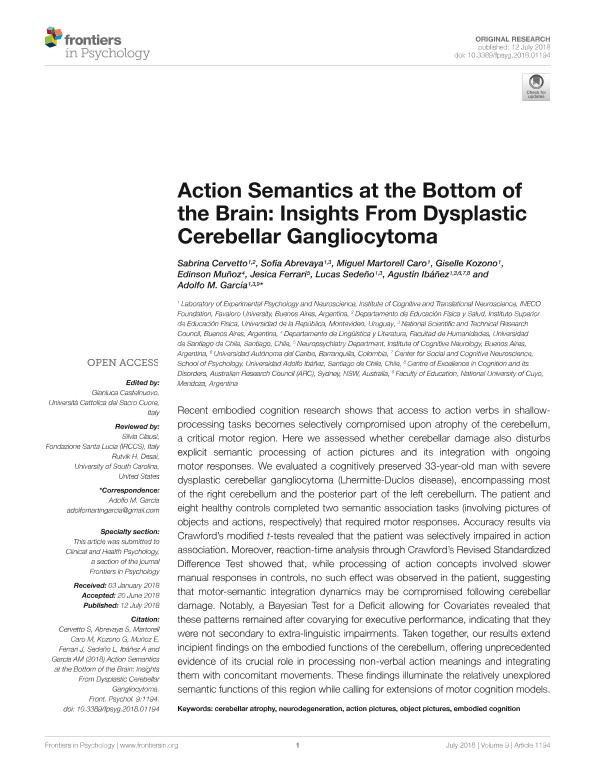Mostrar el registro sencillo del ítem
dc.contributor.author
Cervetto Manciameli, Sabrina Fabiana

dc.contributor.author
Abrevaya, Sofia

dc.contributor.author
Martorell Caro, Miguel Angel

dc.contributor.author
Kozono, Giselle
dc.contributor.author
Muñoz, Edinson
dc.contributor.author
Ferrari, Jesica
dc.contributor.author
Sedeño, Lucas

dc.contributor.author
Ibañez, Agustin Mariano

dc.contributor.author
García, Adolfo Martín

dc.date.available
2020-03-12T21:12:14Z
dc.date.issued
2018-07
dc.identifier.citation
Cervetto Manciameli, Sabrina Fabiana; Abrevaya, Sofia; Martorell Caro, Miguel Angel; Kozono, Giselle; Muñoz, Edinson; et al.; Action semantics at the bottom of the brain: Insights from dysplastic cerebellar gangliocytoma; Frontiers Research Foundation; Frontiers in Psychology; 9; 1194; 7-2018; 1-10
dc.identifier.issn
1664-1078
dc.identifier.uri
http://hdl.handle.net/11336/99408
dc.description.abstract
Recent embodied cognition research shows that access to action verbs in shallow-processing tasks becomes selectively compromised upon atrophy of the cerebellum, a critical motor region. Here we assessed whether cerebellar damage also disturbs explicit semantic processing of action pictures and its integration with ongoing motor responses. We evaluated a cognitively preserved 33-year-old man with severe dysplastic cerebellar gangliocytoma (Lhermitte-Duclos disease), encompassing most of the right cerebellum and the posterior part of the left cerebellum. The patient and eight healthy controls completed two semantic association tasks (involving pictures of objects and actions, respectively) that required motor responses. Accuracy results via Crawford's modified t-tests revealed that the patient was selectively impaired in action association. Moreover, reaction-time analysis through Crawford's Revised Standardized Difference Test showed that, while processing of action concepts involved slower manual responses in controls, no such effect was observed in the patient, suggesting that motor-semantic integration dynamics may be compromised following cerebellar damage. Notably, a Bayesian Test for a Deficit allowing for Covariates revealed that these patterns remained after covarying for executive performance, indicating that they were not secondary to extra-linguistic impairments. Taken together, our results extend incipient findings on the embodied functions of the cerebellum, offering unprecedented evidence of its crucial role in processing non-verbal action meanings and integrating them with concomitant movements. These findings illuminate the relatively unexplored semantic functions of this region while calling for extensions of motor cognition models.
dc.format
application/pdf
dc.language.iso
eng
dc.publisher
Frontiers Research Foundation

dc.rights
info:eu-repo/semantics/openAccess
dc.rights.uri
https://creativecommons.org/licenses/by/2.5/ar/
dc.subject
ACTION PICTURES
dc.subject
CEREBELLAR ATROPHY
dc.subject
EMBODIED COGNITION
dc.subject
NEURODEGENERATION
dc.subject
OBJECT PICTURES
dc.subject.classification
Neurociencias

dc.subject.classification
Medicina Básica

dc.subject.classification
CIENCIAS MÉDICAS Y DE LA SALUD

dc.title
Action semantics at the bottom of the brain: Insights from dysplastic cerebellar gangliocytoma
dc.type
info:eu-repo/semantics/article
dc.type
info:ar-repo/semantics/artículo
dc.type
info:eu-repo/semantics/publishedVersion
dc.date.updated
2020-03-10T12:25:31Z
dc.journal.volume
9
dc.journal.number
1194
dc.journal.pagination
1-10
dc.journal.pais
Suiza

dc.description.fil
Fil: Cervetto Manciameli, Sabrina Fabiana. Consejo Nacional de Investigaciones Científicas y Técnicas. Oficina de Coordinación Administrativa Houssay. Instituto de Neurociencia Cognitiva. Fundación Favaloro. Instituto de Neurociencia Cognitiva; Argentina. Universidad de la República; Uruguay
dc.description.fil
Fil: Abrevaya, Sofia. Consejo Nacional de Investigaciones Científicas y Técnicas. Oficina de Coordinación Administrativa Houssay. Instituto de Neurociencia Cognitiva. Fundación Favaloro. Instituto de Neurociencia Cognitiva; Argentina
dc.description.fil
Fil: Martorell Caro, Miguel Angel. Consejo Nacional de Investigaciones Científicas y Técnicas. Oficina de Coordinación Administrativa Houssay. Instituto de Neurociencia Cognitiva. Fundación Favaloro. Instituto de Neurociencia Cognitiva; Argentina
dc.description.fil
Fil: Kozono, Giselle. Consejo Nacional de Investigaciones Científicas y Técnicas. Oficina de Coordinación Administrativa Houssay. Instituto de Neurociencia Cognitiva. Fundación Favaloro. Instituto de Neurociencia Cognitiva; Argentina
dc.description.fil
Fil: Muñoz, Edinson. Universidad de Santiago de Chile; Chile
dc.description.fil
Fil: Ferrari, Jesica. Instituto de Neurología Cognitiva; Argentina
dc.description.fil
Fil: Sedeño, Lucas. Consejo Nacional de Investigaciones Científicas y Técnicas. Oficina de Coordinación Administrativa Houssay. Instituto de Neurociencia Cognitiva. Fundación Favaloro. Instituto de Neurociencia Cognitiva; Argentina
dc.description.fil
Fil: Ibáñez Barassi, Agustín Mariano. Australian Research Council; Australia. Consejo Nacional de Investigaciones Científicas y Técnicas. Oficina de Coordinación Administrativa Houssay. Instituto de Neurociencia Cognitiva. Fundación Favaloro. Instituto de Neurociencia Cognitiva; Argentina. Universidad Autónoma del Caribe; Colombia. Universidad Adolfo Ibañez; Chile
dc.description.fil
Fil: García, Adolfo Martín. Consejo Nacional de Investigaciones Científicas y Técnicas. Oficina de Coordinación Administrativa Houssay. Instituto de Neurociencia Cognitiva. Fundación Favaloro. Instituto de Neurociencia Cognitiva; Argentina. Universidad Nacional de Cuyo; Argentina
dc.journal.title
Frontiers in Psychology
dc.relation.alternativeid
info:eu-repo/semantics/altIdentifier/url/https://www.frontiersin.org/article/10.3389/fpsyg.2018.01194/full
dc.relation.alternativeid
info:eu-repo/semantics/altIdentifier/doi/http://dx.doi.org/10.3389/fpsyg.2018.01194
Archivos asociados
